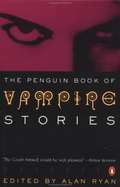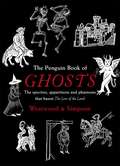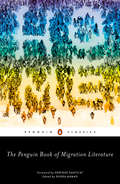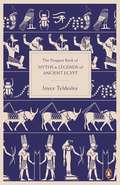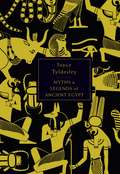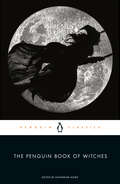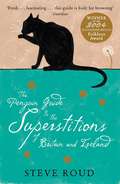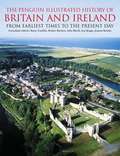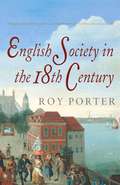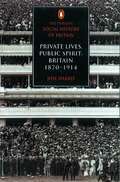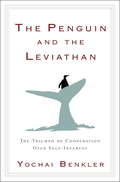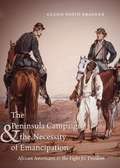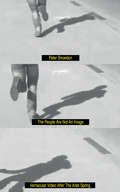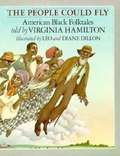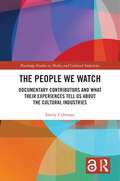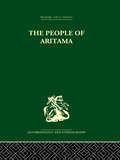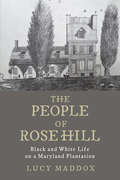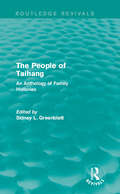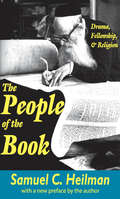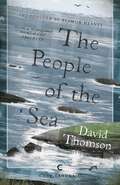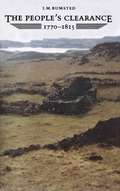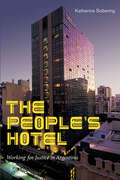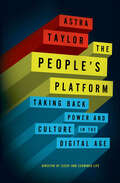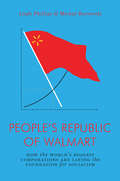- Table View
- List View
The Penguin Book Of Vampire Stories
by Alan RyanThey're lurking under the cover of darkness … and between the covers of this book. Here, in all their horror and all their glory, are the great vampires of literature: male and female, invisible and metamorphic, doomed and daring. Their skin deathly pale, their nails curved like claws, their fangs sharpened for the attack, they are gathered for the kill and for the chill, brought frighteningly to life by Bram Stoker, Fritz Leiber, Richard Matheson, Robert Bloch, Charles L. Grant, Tanith Lee, and other masters of the macabre. Careful—they are all crafty enough to steal their way into your imagination and steal away your hopes for a restful sleep.
The Penguin Book of Ghosts: Haunted England
by Jacqueline Simpson Jennifer WestwoodShiver at the story of the malevolent apparition of 50 Berkeley Square no one has survived seeing. Listen for the tapping cane, when Jeremy Bentham’s mummified body walks through the corridors of University College. Watch out for the Roman centurion who still patrols the causeway linking Mersea Island to Essex. Shudder at the ghosts of kings and queens that keep returning to their old home at Windsor. Beware the black dog of Shap Fell: a sighting presages fatal accidents. England’s history echoes with stories of unquiet spirits and hauntings, of headless highwaymen and grey ladies, of premonitions of death and indelible blood-stains. Here, county by county and place by place, Jennifer Westwood and Jacqueline Simpson gather together all the most interesting supernatural tales from The Lore of the Land. From a ghostly army marching across Cumbria to landlords’ appeals against rates (because no one will rent their haunted house), from the phantom hitchhiker of the Blackwall Tunnel to Francis Drake’s drum summoning him when England is in danger, these fascinating and unforgettable stories are part of our legendary past – and present.
The Penguin Book of Migration Literature: Departures, Arrivals, Generations, Returns
by Edwidge Danticat Dohra AhmadThe first global anthology of migration literature featuring works by Mohsin Hamid, Zadie Smith, Marjane Satrapi, Salman Rushdie, and Warsan Shire, with a foreword by Edwidge Danticat, author of Everything Inside<P><P>A Penguin Classic<P><P>Every year, three to four million people move to a new country. From war refugees to corporate expats, migrants constantly reshape their places of origin and arrival. This selection of works collected together for the first time brings together the most compelling literary depictions of migration. <P><P>Organized in four parts (Departures, Arrivals, Generations, and Returns), The Penguin Book of Migration Literature conveys the intricacy of worldwide migration patterns, the diversity of immigrant experiences, and the commonalities among many of those diverse experiences. Ranging widely across the eighteenth through twenty-first centuries, across every continent of the earth, and across multiple literary genres, the anthology gives readers an understanding of our rapidly changing world, through the eyes of those at the center of that change. With thirty carefully selected poems, short stories, and excerpts spanning three hundred years and twenty-five countries, the collection brings together luminaries, emerging writers, and others who have earned a wide following in their home countries but have been less recognized in the Anglophone world. <P><P>Editor of the volume Dohra Ahmad provides a contextual introduction, notes, and suggestions for further exploration.
The Penguin Book of Myths and Legends of Ancient Egypt
by Joyce TyldesleyThe civilization we know as Ancient Egypt stretched over 3000 years. What was life like for ancient Egyptians? What were their beliefs—and how different were they from ours? Myths and Legends of Ancient Egypt uses Egypt's vivid narratives to create a panorama of its history, from the earliest settlers to the time of Cleopatra. Gathered from pyramid texts, archaeological finds, and contemporary documents, these stories cover everything from why the Nile flooded annually to Egyptian beliefs about childbirth and what happened after death. They show us what life was really like for rich and poor, man and woman, farmer and pharaoh. Myths and Legends of Ancient Egypt brings a long-dead culture back to life.
The Penguin Book of Myths and Legends of Ancient Egypt
by Joyce TyldesleyFrom Herodotus to The Mummy, Western civilization has long been fascinated with the exotic myths and legends of Ancient Egypt but they have often been misunderstood. Here acclaimed Egyptologist Joyce Tyldesley guides us through 3000 years of changing stories and, in retelling them, shows us what they mean. Gathered from pyramid friezes, archaological finds and contemporary documents, these vivid and strange stories explain everything from why the Nile flooded every year to their beliefs about what exactly happened after death and shed fascinating light on what life was like for both rich and poor. Lavishly illustrated with colour pictures, maps and family trees, helpful glossaries explaining all the major gods and timelines of the Pharoahs and most importantly packed with unforgettable stories, this book offers the perfect introduction to Egyptian history and civilization.
The Penguin Book of Witches
by Katherine HoweChilling real-life accounts of witches, from medieval Europe through colonial America From a manual for witch hunters written by King James himself in 1597, to court documents from the Salem witch trials of 1692, to newspaper coverage of a woman stoned to death on the streets of Philadelphia while the Continental Congress met, The Penguin Book of Witches is a treasury of historical accounts of accused witches that sheds light on the reality behind the legends. Bringing to life stories like that of Eunice Cole, tried for attacking a teenage girl with a rock and buried with a stake through her heart; Jane Jacobs, a Bostonian so often accused of witchcraft that she took her tormentors to court on charges of slander; and Increase Mather, an exorcism-performing minister famed for his knowledge of witches, this volume provides a unique tour through the darkest history of English and North American witchcraft.
The Penguin Guide to the Superstitions of Britain and Ireland
by Steve RoudAre black cats lucky or unlucky? What should you do when you hear the first cuckoo? Since when have people believed that it's unlucky to shoot an albatross? Why does breaking a mirror lead to misfortune? This fascinating collection answers these and many other questions about the world of superstitions and forms an endlessly browsable guide to a subject that continues to obsess and intrigue.
The Penguin Illustrated History of Britain and Ireland: From Earliest Times to the Present Day
by Barry Cunliffe Robert Bartlett Joanna Bourke Asa Briggs John MorrillIn this illustrated history of England, Scotland, Wales, and Ireland, the reader is taken on a journey from prehistoric times to the present day, examining such topics as the spread of literacy, the development of transport, and the evolution of country houses on the way. British cities are brought to life in artwork reconstructions that take the reader back to the Dublin of the 18th century or London in the 1850s.
The Penguin Social History of Britain: English Society in the Eighteenth Century
by Roy PorterA portrait of 18th century England, from its princes to its paupers, from its metropolis to its smallest hamlet. The topics covered include - diet, housing, prisons, rural festivals, bordellos, plays, paintings, and work and wages.
The Penguin Social History of Britain: Private Lives, Public Spirit: Britain 1870-1914
by Dr Jose HarrisThe late nineteenth century and Edwardian era, suggests Jose Harris in this book, represent a sharp break with the early years of Queen Victoria's reign. Indeed, despite the intense upheavals of two world wars, it was the beliefs, social structures and oppositional forces established between 1870 and 1914 which dominated British life right up until the 1960s.
The Penguin and the Leviathan: How Cooperation Triumps Over Self-interest
by Yochai BenklerWhat do Wikipedia, Zip Car's business model, Barack Obama's presidential campaign, and a small group of lobster fishermen have in common? They all show the power and promise of human cooperation in transforming our businesses, our government, and our society at large. Because today, when the costs of collaborating are lower than ever before, there are no limits to what we can achieve by working together.For centuries, we as a society have operated according to a very unflattering view of human nature: that, humans are universally and inherently selfish creatures. As a result, our most deeply entrenched social structures - our top-down business models, our punitive legal systems, our market-based approaches to everything from education reform to environmental regulation - have been built on the premise that humans are driven only by self interest, programmed to respond only to the invisible hand of the free markets or the iron fist of a controlling government. In the last decade, however, this fallacy has finally begun to unravel, as hundreds of studies conducted across dozens of cultures have found that most people will act far more cooperatively than previously believed. Here, Harvard University Professor Yochai Benkler draws on cutting-edge findings from neuroscience, economics, sociology, evolutionary biology, political science, and a wealth of real world examples to debunk this long-held myth and reveal how we can harness the power of human cooperation to improve business processes, design smarter technology, reform our economic systems, maximize volunteer contributions to science, reduce crime, improve the efficacy of civic movements, and more. For example, he describes how: * By building on countless voluntary contributions, open-source software communities have developed some of the most important infrastructure on which the World Wide Web runs * Experiments with pay-as-you-wish pricing in the music industry reveal that fans will voluntarily pay far more for their favorite music than economic models would ever predic * Many self-regulating communities, from the lobster fishermen of Maine to farmers in Spain, live within self-regulating system for sharing and allocating communal resources * Despite recent setbacks, Toyota's collaborative shop-floor, supply chain, and management structure contributed to its meteoric rise above its American counterparts for over a quarter century. * Police precincts across the nation have managed to reduce crime in tough neighborhoods through collaborative, trust-based, community partnerships. A must-read for anyone who wants to understand the dynamics of cooperation in 21st century life, The Penguin and the Leviathan not only challenges so many of the ways in which we live and work, it forces us to rethink our entire view of human nature.From the Hardcover edition.
The Peninsula Campaign and the Necessity of Emancipation
by Glenn David BrasherIn the Peninsula Campaign of spring 1862, Union general George B. McClellan failed in his plan to capture the Confederate capital and bring a quick end to the conflict. But the campaign saw something new in the war--the participation of African Americans in ways that were critical to the Union offensive. Ultimately, that participation influenced Lincoln's decision to issue the Emancipation Proclamation at the end of that year. Glenn David Brasher's unique narrative history delves into African American involvement in this pivotal military event, demonstrating that blacks contributed essential manpower and provided intelligence that shaped the campaign's military tactics and strategy and that their activities helped to convince many Northerners that emancipation was a military necessity.Drawing on the voices of Northern soldiers, civilians, politicians, and abolitionists as well as Southern soldiers, slaveholders, and the enslaved, Brasher focuses on the slaves themselves, whose actions showed that they understood from the outset that the war was about their freedom. As Brasher convincingly shows, the Peninsula Campaign was more important in affecting the decision for emancipation than the Battle of Antietam.
The People Are Not an Image: Vernacular Video After the Arab Spring
by Peter SnowdonA major intervention in media studies theorizes the politics and aesthetics of internet videoThe wave of uprisings and revolutions that swept the Middle East and North Africa between 2010 and 2012 were most vividly transmitted throughout the world not by television or even social media, but in short videos produced by the participants themselves and circulated anonymously on the internet.In The People Are Not An Image, Snowdon explores this radical shift in revolutionary self-representation, showing that the political consequences of these videos cannot be located without reference to their aesthetic form. Looking at videos from Tunisia, Bahrain, Syria, Libya, and Egypt, Snowdon attends closely to the circumstances of both their production and circulation, drawing on a wide range of historical and theoretical material, to discover what they can tell us about the potential for revolution in our time and the possibilities of video as a genuinely decentralized and vernacular medium.
The People Could Fly: American Black Folktales
by Virginia Hamilton24 folktales briefly and dramatically told lend themselves to be read aloud or acted out around campfires, on stormy nights, or to be discussed for readers of all ages. Their heroes prevail through cleverness, perseverance, quick thinking and, often, magic. The stories come from far and wide where enslavement of Africans was practiced from Portugal, to the United States, to the Cape Verde Islands. After each story, Virginia Hamilton, the Newberry Award winning author, provides concise information about its source, history, symbols, storytelling elements and interpretation. Find out how the lion who goes about scaring the other animals by roaring, "Me and myself!" is silenced, how Little Daughter evades a stalking wolf with her goodest, sweetest, song, and how a man whose horse and grandmother is killed by a bully, avoids being killed himself, becomes wealthy, and brings the brute to justice. In one story a young man uses his three obedient rabbits to outwit a princess, queen, and king, catching them in a sackful of lies. Another story warns that should you ever cut off a creature's big , long tail and eat it, it will come for you in the night calling for you to give it's, "tailypo," back. It will creep up your wall, through your window, across your floor, on to your bed and you'll be too scared to move, too scared to scream...<P><P>Winner of the Coretta Scott King Medal
The People We Watch: Documentary Contributors and What Their Experiences Tell Us About the Cultural Industries (Routledge Studies in Media and Cultural Industries)
by Emily ColemanThe People We Watch explores the politics of contemporary media production from the point of view of the ordinary people it represents.Based upon a series of in-depth interviews and the author’s own professional experience of working in the television industry, this book examines how documentary contributors feel about participating in the media and the ways they are portrayed, considering how their experiences take shape within the structural context of the cultural industries.This insightful text will interest scholars, students, and researchers in media and communication, sociology of the media, documentary studies, and film studies, as well as those studying the cultural industries, media production, creative labour, and cultural policy.The Open Access version of this book, available at www.taylorfrancis.com, has been made available under a Creative Commons Attribution-Non Commercial-No Derivatives (CC-BY-NC-ND) 4.0 International license.Any third party material in this book is not included in the OA Creative Commons license, unless indicated otherwise in a credit line to the material. Please direct any permissions enquiries to the original rightsholder.This work was supported by the Arts and Humanities Research Council [grant number AH/L503848/1]; and the Economic and Social Research Council [grant number ES/Y007808/1].
The People of Aritama: The Cultural Personality of a Colombian Mestizo Village (Routledge Library Editions)
by Alicia Reichel-Dolmatoff Gerardo Reichel-DolmatoffThis book covers the life of a small Mestizo community in Columbia, with its people and institutions, its traditions in the past and its outlook on the future. Chapters include: · information on the health and nutritional status of the community * discussion of formal education and certain sets of patterned attitudes such as those which refer to work, illness, food and personal prestige. Originally published in 1961.
The People of Rose Hill: Black and White Life on a Maryland Plantation
by Lucy MaddoxWhat was antebellum life like for the two communities of people—one white and one black—who lived and worked on a plantation on the Eastern Shore of Maryland?Thomas Marsh Forman was in his early twenties when he returned from the Revolutionary War to take over the proprietorship of Rose Hill plantation from his father. The estate lay alongside the Sassafras River in Cecil County, on Maryland's Eastern Shore. Rose Hill was a product of its historical moment, a moment in which men like Forman acted on their belief that the future prospects of the country required a continuation not only of their energy, their skills, and their desire to improve the lives of Americans but also of the slave economy they had done so much to shape. A focused study of this one plantation, The People of Rose Hill illuminates the workings of the entire plantation system in the border region between the end of the Revolution and the approach of the Civil War. Lucy Maddox looks closely at the public and private lives of the people of Rose Hill, who labored together in a profitable agricultural enterprise while maintaining relationships with one another that were cautious, distant, sometimes secretive, and often explosive. Making extensive use of the letters of wife, Martha Ogle Forman, Maddox places the experiences of Rose Hill's inhabitants (enslaved and free) within the context of the cultural, economic, and political history of the state. Piecing together the scattered information in these documents, she offers readers fascinating insights into life and labor on the plantation, from grueling daily work schedules to menus for elaborate dinners and teas. Her account includes comparative analyses of family structures and social practices within the Forman family and in the community of enslaved workers. Individual sections profile thirty-eight of the fifty enslaved people at Rose Hill, identifying, as far as possible, that person's primary work responsibilities, family connections, and history at the plantation, thus giving each a recognized place in the larger history of plantation slavery in the Upper South. Maddox's discussion of Rose Hill extends to the places around it where the slave culture of the plantation found confirmation and support: churches, law courts, social gatherings, agricultural fairs and societies, the parlors and sitting rooms of the Eastern Shore elite. The People of Rose Hill is a fascinating look at the intersection of the constricted world of the plantation with the larger world of early America.
The People of Taihang: An Anthology of Family Histories (Routledge Revivals)
by Sidney L. GreenblattThe Taihang Mountains lay on the border between Shansi and Hopei in China and originally published in 1972, this edited anthology collates family histories as told by the people who lived there. These accounts are a small sample of the family histories that made up the Taihang community taken from poor or lower-middle peasants to discuss the hardships they faced in the early twentieth century and to provide insight into a rural life to a new generation of Chinese youths. This title will be of interest to students of Asian studies and Anthropology.
The People of the Book: Drama, Fellowship and Religion
by Samuel C. HeilmanJudaism has long derived its identity from its sacred books. The book or scroll--rather than the image or idol--has been emblematic of Jewish faith and tradition. The People of the Book presents a study of a group of Orthodox Jews, all of whom live in the modern world, engaged in the time-honored practice of lernen, the repeated review and ritualized study of the sacred texts. In preserving one of the activities of Jewish life, Samuel C. Heilman argues, these are the genuine -People of the Book.- For two years, Heilman participated in and observed five study circles in New York and Jerusalem engaged in the avocation of lernen the Talmud, the great corpus of Jewish law, lore, and tradition. These groups, made up of men who felt the ritualized study of sacred texts to be not only a religious obligation but also an appealing way to spend their evenings, weekends, and holidays, assembled together under the guidance of a teacher to review the holy books of their people. Having become part of this world, the author is able to provide first-hand observation of the workings of the study circle. Heilman's study moves beyond the merely descriptive into an analysis of the nature and meaning of activity he observed. To explain the character and appeal of the study groups, he employs three concepts: drama, fellowship, and religion. Inherent to the life of the study circle are various sorts of drama: -social dramas- playing out social relationships, -cultural performances- reenacting the Jewish world view, and -interactional dramas- and -word plays- involving the intricacies of the recitation and translation process. This book will be of interest to anthropologists and those interested in the academic study of religion.
The People of the Sea: Celtic Tales of the Seal-Folk (Canons #8)
by David Thomson&“Readers will be carried away on successive waves of pleasure [and] irresistible holistic beauty&” in this journey to uncover myths of Selchies (Seamus Heaney, from the introduction). When author David Thomson travelled across the coasts of Scotland and Ireland to seek out the legend of the selchies—mythological creatures who transform from seals into humans—a magical world emerged before him. Thomson was enchanted by tales of men rescued by seals in stormy seas, and others who took seal-women for their wives and had their children suckled by seal-mothers. The People of the Sea is Thomson&’s poetic record of his journey into this world, and his encounters with people whose connection to the sea and its fertile lore runs deep. Winner of the McVitie Prize for his memoir Nairn in Darkness and Light, David Thomson offers &“a splendid resurrection of a life that has almost vanished.&” Timeless and haunting, The People of the Sea retains its spellbinding charm and brings to life the enchanting stories of these mysterious creatures of Celtic folklore (Daily Telegraph, UK).&“I know of few books which so ably open a window on the Gaelic scene today or which so faithfully reflect the mind, vigour and courtesy of its people…Pounds on the imagination like surf on a reef&”—Observer, UK
The People's Clearance: Highland Emigration to British North America, 1770-1815
by J.M. BumstedThis is a revisionist account of Highland Scottish emigration to what is now Canada, in the formative half century before Waterloo.
The People's Hotel: Working for Justice in Argentina
by Katherine SoberingIn 2001 Argentina experienced a massive economic crisis: businesses went bankrupt, unemployment spiked, and nearly half the population fell below the poverty line. In the midst of the crisis, Buenos Aires’s iconic twenty-story Hotel Bauen quietly closed its doors, forcing longtime hospitality workers out of their jobs. Rather than leaving the luxury hotel vacant, a group of former employees occupied the property and kept it open. In The People’s Hotel, Katherine Sobering recounts the history of the Hotel Bauen, detailing its transformation from a privately owned business into a worker cooperative—one where decisions were made democratically, jobs were rotated, and all members were paid equally. Combining ethnographic and archival research with her own experiences as a volunteer worker at the hotel, Sobering examines how the Bauen Cooperative grew and, against all odds, successfully kept the hotel open for nearly two decades. Highlighting successes and innovations alongside the many challenges that these workers faced, Sobering presents a vivid portrait of efforts to address inequality and reorganize work in a capitalist economy.
The People's Platform: Taking Back Power and Culture in the Digital Age
by Astra Taylor“An invaluable primer for anyone seeking to understand why our networked world isn’t all that it is cracked up to be.” —The GuardianThe Internet has been hailed as an unprecedented democratizing force, a place where everyone can be heard and all can participate equally. But how true is this claim? In a seminal dismantling of techno-utopian visions, The People’s Platform argues that for all that we “tweet” and “like” and “share,” the Internet in fact reflects and amplifies real-world inequities at least as much as it ameliorates them. Online, just as off-line, attention and influence largely accrue to those who already have plenty of both.What we have seen so far, Astra Taylor says, has been not a revolution but a rearrangement. Although Silicon Valley tycoons have eclipsed Hollywood moguls, a handful of giants like Amazon, Apple, Google, and Facebook remain the gatekeepers. And the worst habits of the old media model—the pressure to seek easy celebrity, to be quick and sensational above all—have proliferated on the web, where “aggregating” the work of others is the surest way to attract eyeballs and ad revenue. When culture is “free,” creative work has diminishing value and advertising fuels the system. The new order looks suspiciously like the old one.We can do better, Taylor insists. The online world does offer a unique opportunity, but a democratic culture that supports diverse voices and work of lasting value will not spring up from technology alone. If we want the Internet to truly be a people’s platform, we will have to make it so.“Beautifully written and highly recommended.” —David Byrne, musician and author
The People's Republic of Walmart: How the World's Biggest Corporations are Laying the Foundation for Socialism (Jacobin)
by Leigh Phillips Michal RozworskiSince the demise of the USSR, the mantle of the largest planned economies in the world has been taken up by the likes of Walmart, Amazon and other multinational corporations For the left and the right, major multinational companies are held up as the ultimate expressions of free-market capitalism. Their remarkable success appears to vindicate the old idea that modern society is too complex to be subjected to a plan. And yet, as Leigh Phillips and Michal Rozworski argue, much of the economy of the West is centrally planned at present. Not only is planning on vast scales possible, we already have it and it works. The real question is whether planning can be democratic. Can it be transformed to work for us? An engaging, polemical romp through economic theory, computational complexity, and the history of planning, The People’s Republic of Walmart revives the conversation about how society can extend democratic decision-making to all economic matters. With the advances in information technology in recent decades and the emergence of globe-straddling collective enterprises, democratic planning in the interest of all humanity is more important and closer to attainment than ever before.
